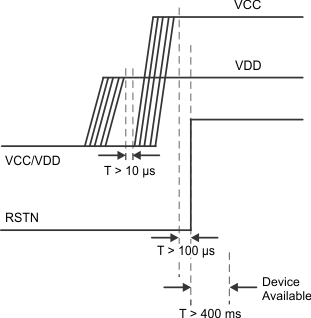ZHCSD29A November 2014 – November 2014 TVB1440
PRODUCTION DATA.
- 1 特性
- 2 应用
- 3 说明
- 4 简化电路原理图
- 5 修订历史记录
- 6 Pin Configuration and Functions
- 7 Specifications
- 8 Detailed Description
- 9 Application and Implementation
- 10Power Supply Recommendations
- 11Layout
- 12器件和文档支持
- 13机械封装和可订购信息
10 Power Supply Recommendations
The following power-up and power-down sequences describe how the RSTN signal is applied to the TVB1440.
10.1 Power-Up Sequence
- Apply VDD then VCC (recommended both less than 10-ms ramp time). VDD must be asserted first and stable for greater than 10 μs before VCC is applied.
- RSTN must remain asserted until VCC/VDD voltage has reached minimum recommended operation for more than 100 μs.
- De-assert RSTN (Note: This RSTN is a 1.1V interface and is internally connected to VDD through a 150-kΩ resistor).
- Device will be available for operation approximately 400 ms after a valid reset.
 Figure 15. Power-up Sequence
Figure 15. Power-up Sequence
10.2 Power-Down Sequence
There is no power-down sequence required.